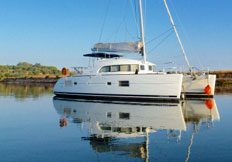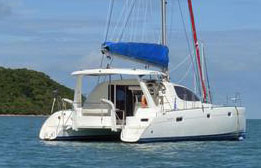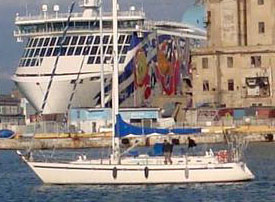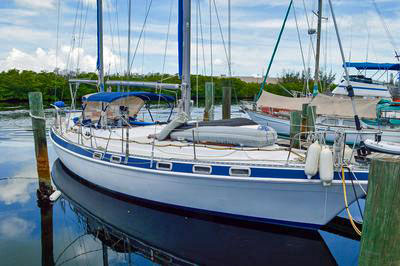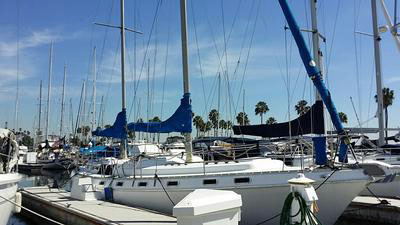| Back to Back Issues Page |
 |
|
The Sailboat Cruiser ~ Issue #26 February 24, 2016 |
HiThe Sailboat CruiserThe Sailboat Cruiser is the free monthly newsletter of sailboat-cruising.com and sets out to bring you the news, views and general musings of, well, me - Dick McClary, a sailboat cruiser and creator/owner of the website. If you like this newsletter, please feel free to email it to your friends. If one of your friends did forward this to you and you like what you read, please subscribe by visiting The Sailboat Cruiser Newsletter #25 - February 2016What's in This Issue:
To cap it all, one of the two friends who came with us on our shakedown cruise off Grenada's south coast took a heavy fall below and broke two ribs. The forecast was for 15 to 20 knots of wind. Ideal we thought, but not the 35 knots that we actually got. The fall completely winded her, she was in great pain and struggling to breathe. I was worried that she may have punctured a lung. Fortunately that wasn't the case and I'm relieved to say that she's now on the mend. She's a very experienced skipper, and extremely fit and agile - it brought home to me just how risky this wonderful pastime of ours can be. We've now left Grenada, sailing north to the Tyrrel Bay anchorage on Carriacou and on to the Charlestown Bay anchorage on Canouan. As I write this we're anchored in Admiralty Bay on Bequia - it's a tough life... 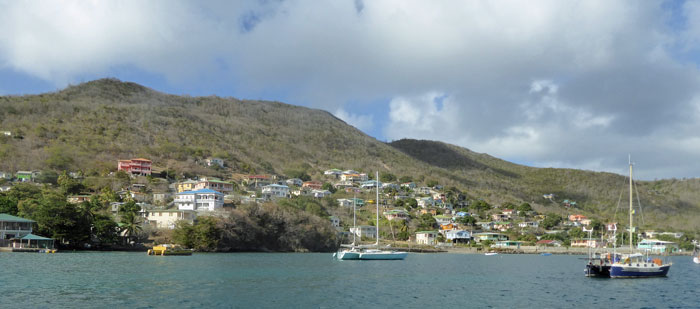
DIY Fuel PolishingWe'd met John and his wife Jill last year in Montserrat and had become good pals. He was telling me about the problem they'd got with the fuel tanks on their steel boat."It's the rust" he said, "The tanks are corroding from the inside out. You should see the muck that collects in my fuel/water separator." He invited me over to take a look. His concern was well justified - the clear section of the separator was half full of rust particles. There is a mobile fuel cleaning service available in Prickly Bay but it meant taking the boat alongside and having all the fuel pumped out, following which a mobile pump/filtration machine 'polishes' it. That's the word the operating company uses. It was a relatively expensive service, which would have absorbed more of their cruising funds than they'd ideally like to part with. There had to be another way, and there was... First, the inlet and outlet pipes on the fuel/water separator were disconnected and replaced with two long lengths of reinforced plastic pipe. On the end of the tube from the inlet side of the fuel/oil separator a 12v in-line fuel pump was connected. Now the clever bit. The in-line pump was inserted into the fuel tank through an inspection hatch, the other return pipe was inserted through the same inspection hatch and the pump switched on. Very soon the clear bowl part of the fuel/water separator was half full of rust particles. This was emptied out and the process was repeated with John poking the suction pipe into all areas of the floor of the tank. After a while no further rust particles were finding their way to the bowl. Job done, and 10 out of 10 for innovation! Of course this was only a temporary solution - sooner or later something's going to have to be done about those steel tanks.
Fuel Tank Inspection PlatesThis set me thinking about the condition of the fuel in Alacazam's polypropylene tanks. The fuel in the clear bowl of the fuel/water separator looked fine, but...The truth is I'd never actually looked at the fuel in the bottom of the tank. I was fairly confident it would be OK, as there'd be no rust of course, and I always keep the tanks topped up and use an anti-bug additive when the boat's laid up ashore.
All the fuel was pumped out and two new stainless steel access plates (www.seabuilt.com) were installed which enabled us to properly clean out all the gunge that had been lurking at the bottom of the tank. Fortunately the fuel and water tanks on Alacazam are easily accessible, with the central fuel tank flanked by the water tanks. I shall be taking a look in there every season from here on...
All Crossed UpFlushed with our success, John and I were relaxing with a cold beer. Conversation got around the nervy time of launching after longterm storage ashore - a recent event for both of us.What's not going to work now that was working perfectly when she was hauled out? Launched in the slip, but still hanging in the slings below the travel hoist, they'd gone through the usual checks - no leaking seacocks, engine starts OK, rudder turns freely, astern and forward gear engaging properly. With everything working as expected they motored out of the dock. It was necessary to turn to port to avoid some moored boats. Jill turned to port, the boat turned to starboard. Jill turned further to port, the boat went further to starboard. PANIC! Fortunately one of the line handlers had forgotten to let go the sternline that he was in charge of, so total carnage and mayhem among the moored boats was narrowly avoided. But how did it happen? Prior to launching, John had done some work on the boat's steering gear - and had somehow got his wire's crossed. A mistake he's unlikely to make again. John did ask me not to mention the further embarrassment he experienced when he later hoisted his jib upside down - so I won't.
Syphoning Technique - Blow, don't Suck!Who hasn't ended up with a mouthful of something unpleasant when sucking on a syphon tube?Use the following technique and it won't happen again. Let's say that you want to syphon fuel from a 5 gallon plastic fuel canister into your boat's fuel tank. First put one end of the syphon tube into the canister - near the bottom - and the other end into the fuel tank. With your hands, form a seal around the syphon tube and the mouth of the plastic canister leaving just enough space to blow into the canister with your mouth. This pressurizes the air space above the fuel in the canister and pushes the fuel up the syphon tube and into the fuel tank. Once it starts flowing you can stop blowing and release your hands - your syphon will continue until the canister is empty. Magic!
Grenada Sailing Festival - The Workboat RegattaThis seemed too good to miss; traditional Grenada Workboats racing off Grand Anse Beach.The teams that take part come from various sailing, fishing and boat building communities around the island - Grand Mal, Gouyave, Sauteurs and Woburn, plus the Sister Islands of Carriacou and Petit Martinique. The competition is intense. Traditionally, the boats raced were the working fishing boats of the community – 16 or 17 feet long, made from local hardwoods and with masts of bamboo. Today, most boats are built specifically for racing and are carefully stored and maintained to be ready for competition. On average it takes four to six weeks to build a boat from scratch. It's a colourful event... 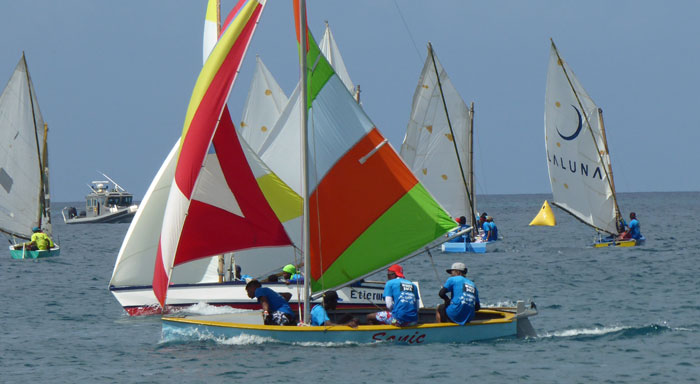
The Zika VirusBack in issue #6 of The Sailboat Cruiser I wrote about the Aedes Aegypti mosquito, a malicious little chap that carries both the Dengue Fever and Chikungunya viruses.Well, now it's added a new dose of nastiness to its repertoire - the ZIKA virus, for which there is no vaccine.  The Zika virus is usually relatively mild, with symptoms such as skin rash, fever, muscle and joint pain, lasting up to seven days.
The Zika virus is usually relatively mild, with symptoms such as skin rash, fever, muscle and joint pain, lasting up to seven days.
It is uncommon for people infected with Zika to need hospital treatment. But it can be extremely dangerous for pregnant women, where it is suspected of being linked to microcephaly, a neurological disorder in which babies are born with smaller than normal heads and brains. There's currently an outbreak of this horrendous disease throughout South America and various parts of the Caribbean. Here's what the World Health Organisation has to say about it on their
zika virus fact sheet...
Used Gear for SaleSeveral of you have been having a bit of a clear-out it seems...Plenty of used sailing jackets and trousers to choose from. A navigators case, trapeze harness, safety lines and even a Monitor Windvane Self-Steering gear. Take a look at them
here...
Cruising Boats for SaleTwo catamarans and three monohulls uploaded free of charge by our visitors to sailboat-cruising.com this month...
A Lagoon 380 Cruising Catamaran -
more details...
A Leopard 40 Cruising Catamaran -
more details...
A Taswell 49 -
more details...
A Morgan 416 Out Island -
more details...
A Morgan 41 Out Island Ketch -
more details...
Incidentally, if you're thinking of looking at a secondhand sailboat, or just want to be aware of what to look for - and when to walk away no matter what - then you really ought to take a look at Andrew Simpson's eBook
Secrets of Buying Secondhand Boats...
More 'Likes' Please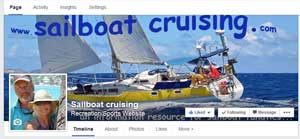 Sailboat-Cruising.com has a Facebook Page!
Sailboat-Cruising.com has a Facebook Page!
Clicking the image here will take you right to it, where you can browse through many more posts and articles. Please take a look, and feel free to make a post - and don't forget to 'Like' us of course... Thanks! Visit sailboat-cruising.com's Facebook Page... And finally...If you know anyone who might be interested in the contents of this newsletter, feel free to email it to them. It's not secret!And this newsletter can be a two-way thing. If you've read anything you'd like to comment on, or perhaps there's an event you'd like to see announced in a future newsletter, then please let me know. See you next month! 
Go to Sailboat-Cruising.com's Home Page... |
| Back to Back Issues Page |
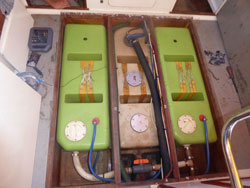 However, using John's in-line pump, we pumped a sample out through the access plate for the fuel gauge proved me wrong. It was not pretty. It was obvious that something had to be done...
However, using John's in-line pump, we pumped a sample out through the access plate for the fuel gauge proved me wrong. It was not pretty. It was obvious that something had to be done...
